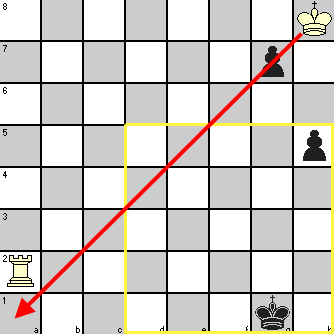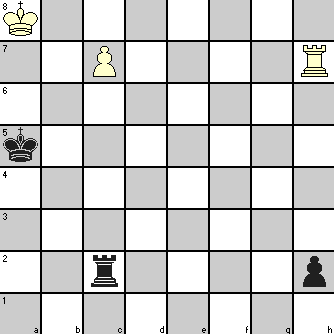In the article suggesting the best way to learn endgame tactics, we laid more stress on endgame plays by top players than on chess problems and chess studies. But at the same time, we pointed out that some of these problems and studies could benefit you in developing ideas on some finer endgame tactics like “underpromotion”, gaining tempo etc., some of which may appear in the same problem or study.
Here we will show you some creative ideas that can stand you in good stead in your actual endgame plays.

In this study by Moravec, White is required to play and win. To decide on your tactics, you should analyze as follows:
- Even with the first move applied to White K to chase the Black RP, it will remain two moves outside ‘the Square’ for that pawn. So if Black continues to push RP, White K will only be on rank 3 when RP reaches h1 to get promoted.
- If White so wants, his K can capture the Black NP in its stride towards the RP
- When White K reaches g3 (after Black RP has reached h1 to become a Queen), Black on his next move cannot deliver a check by his Q with support from his K because of the White R controlling rank 2. Black thus loses a tempo!
- White on the next move can deliver check by Ra1 and because of his K on g3, will cause checkmate! If on the previous move, Black tried Kf1, then check by Rook will result in his loss of Q!
- At step 3, Black Q could go to h8 to control a1-h8 diagonal and the square a1 preventing Rook’s check (and thus retaining the tempo) – provided there were no Black P on g7 blocking that diagonal!
- The conclusion is: White K must not capture the NP at step 2 so as to deny Black any tempo after pawn promotion, which in turn gives him the tempo for delivering checkmate or capturing Black Q!
Once you have understood the idea, the sequence of moves become clear.
| 1. | Kh7 | h4 | not 1. Kxg7 | |
| 2. | Kg6 | h3 | ||
| 3. | Kg5 | h2 | ||
| 4. | Kg4 | h1=Q | ||
| 5. | Kg3 | White wins with 6. Ra1+ |
But Black had a resource that would make White’s win extremely difficult. This comes out of an attempt to gain tempo as shown below!
| 4. | Kg4 | g5 | unblocks the a1-h8 diagonal | |
| 5. | Kg3 | h1=N+ | The under-promotion to Knight gains tempo for Black as White K has to move. White’s K and R against Black’s K and N gives difficult theoretical win for White. |

The above is a study by Lasker but this type of Rook and Pawn ending may come up in actual play. So you should note in the following moves how White combines ‘opposition’ by his King and check by his Rook to push White King away from Black’s QBP while not allowing Black to give check along any row.
| 1. | Kb7 | Rb2+ | ||
| 2. | Ka7 | Rc2 | ||
| 3. | Rh5+ | Ka4 | ||
| 4. | Kb7 | Rb2+ | ||
| 5. | Ka6 | Rc2 | ||
| 6. | Rh4+ | Ka3 | ||
| 7. | Kb6 | Rb2+ | If 7. … Kb3 8. Kb7. If 7. … Ka2 8. Rxh2 | |
| 8. | Ka5 | Rc2 | ||
| 9. | Rh3+ | Ka2 | ||
| 10. | Rxh2 | White gets Queen giving up his Rook and wins |


Trackbacks/Pingbacks